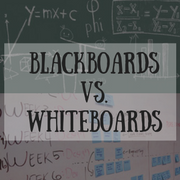- Dry Erase Strip Rolls & Shelf Labels
- Dry Erase Magnetic Sheets & Rolls
- Dry Erase Double Magnetized Sheets & Rolls
- Dry Erase Whiteboard Sheets
- Chalkboard Sheets
- C-Channel Magnetic Data Card Holder Shelf Labels
- Magnetic Photo Protector Sleeves
- Magnetic Rolls
- Magnetic Receptive Rolls
- Double Magnetized Magnet Rolls
- Vehicle Magnet Sign Blanks
- Printable Magnet Sheets
- Adhesive Magnetic Tape & Cut Strips
- Adhesive Magnetic Sheets & Rolls
- Plain Magnetic Sheets & Rolls
- Business Card Magnets
- Inventory Closeout Sale
- Special Orders
Blackboard vs. Whiteboard: Which Material Should I Use?

 Blackboards, also known as chalkboards, are a common staple in classrooms, kitchens, and playrooms, but are whiteboards a better alternative? Both blackboards and whiteboards have benefits and drawbacks, but ultimately, the decision is yours. Personality, needs, and versatility all play a role in choosing the best material for your project.
Blackboards, also known as chalkboards, are a common staple in classrooms, kitchens, and playrooms, but are whiteboards a better alternative? Both blackboards and whiteboards have benefits and drawbacks, but ultimately, the decision is yours. Personality, needs, and versatility all play a role in choosing the best material for your project.
Dust and Allergies
One of the major downfalls of using traditional blackboard material is the uptick of dust it can create. This is something to heavily consider if you have close friends, students, or family members with allergies or asthma. Studies have shown chalk dust to be associated with increased respiratory symptoms, school absences and medication for asthmatic children. Chalk dust is a particulate air pollutant that hangs in the air, where it is inhaled and settles in the airways and lungs of people and animals. Dust that results from the use of blackboards can cause coughing, wheezing, itchy eyes, among other symptoms.
Dust not only creates a health hazard but can become a nuisance to household chores. Dust that is not automatically inhaled, settles and tracks itself across the house or school. Chalk dust that ends up on your hands ends up on the couch and the desk or settles on window sills or table tops waiting to be cleaned.
 Readability and Contrast
Readability and Contrast
Depending on where you want to use your blackboard or whiteboard, contrast could be a deciding factor. If you are deciding between the two materials for a learning environment like a lecture hall, or in a large room or venue, contrast will be important in your choice. Research has shown that dark text on a plain, light colored background allows people to read faster. The contrast of black on white improves comprehension when reading quickly or skimming text. Most people can read black on white up to 32% quicker than reading white on black text. By using dry erase board sheets over blackboard sheets, you can improve contrast and readability when using it.
Coloring and Shading
If you are deciding between chalkboards and whiteboards for design or art, chalkboards are the way to go. Although markers for dry erase board sheets and surfaces come in a wide variety of colors, they aren’t as useful when it comes to coloring or shading. Because writing and drawing with chalk rely on writing with deliberate pressure, you are able to vary the pressure you use to get faint or prominent lines or shade in areas of a drawing. With markers, you are limited to bold lines with opaque shading, as pressure does not change the effect of a marker.
 Environmental Impacts
Environmental Impacts
For the environmentally conscious, a greener solution may be the ultimate factor in whether you choose flexible dry erase board sheets or chalkboard sheets for your next craft or project. When it comes to the material sheets themselves, they are relatively equal in terms of being environmentally friendly, the different comes in the writing utensils. Chalk is a simple product, composed using calcium sulfate or calcium carbonate found naturally in gypsum and limestone. Dry erase markers, however, require a variety of components including plastic, which requires nonrenewable energy to manufacture. Most of these markers are made with polypropylene, which is usually not recyclable. Additionally, chalk is a low-waste product itself and usually packaged with less plastic than markers.
Because both whiteboards and blackboards both serve similar purposes and can be used interchangeable, choosing which one to use often comes down to personal preference. Both materials can be bought in different sizes and functions, such as flexible dry erase board sheets for arts and crafts, magnetic receptive chalkboard sheets to create a chalkboard wall or whiteboard rolls to create teaching aids.
